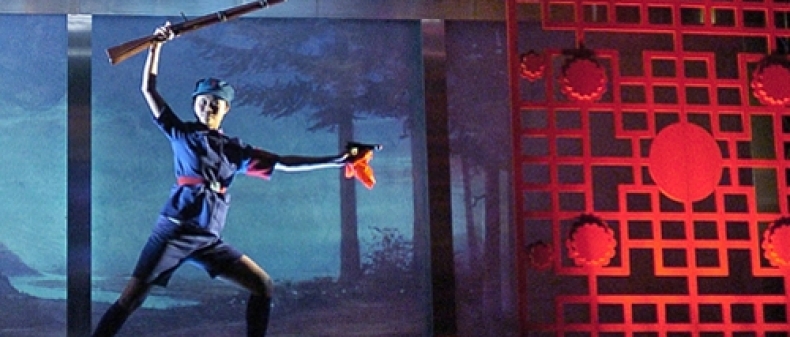
The Blue Dragon was a play long before it was a graphic novel, but Robert Lepage’s visual epic feels like it was born to be a comic book, with its panel-like scenes and the two-dimensional characters caught inside those panels.
Taking place almost twenty years after The Dragons’ Trilogy, this sequel—performed in English, French, and Mandarin—reintroduces us to the kind but impassive Pierre (Henri Chassé), who, after spending the past fifteen years running a gallery in Shanghai, is being forced out of his home to give rise to a train station. Uncertain whether he should fight back or relent, his choice is echoed via a renewed relationship with his ex-wife, Claire (Marie Michaud, who also co-wrote), and a young, impassioned tattoo-artist-turned-fine-artist named Xiao Ling (Tai Wei Foo).
Within the triangle, all three characters nurse an old chestnut of inner struggle, each one corresponding to another in a predictable way. Claire comes to China to adopt a baby, only to be thwarted as Xiao Ling simultaneously discovers that she’s pregnant by Pierre. Also, Claire is an alcoholic. Also, there’s a scene where Pierre tells Claire that she’s an alcoholic, which she vehemently denies, retaliating by calling him out on his character flaws. Even with its enchanted look, The Blue Dragon has a fairly modest plot at its core–the eponymous serpent, a tattoo doubling as hazy metaphor for pain.
If Lepage and Michaud’s script provides the backbone of the production, David Leclerc’s dizzying projections are another kind of tattoo, emblazoning the thin story with figurative ink and disguising the softness of the body beneath it.
Looking to some of Lepage’s older work, his personal references and interests are more wittily and forcefully present–like his appreciation of Asian aesthetics, as evidenced by The Seven Streams of the River Ota and its partial adaptation in his 1998 film Nô. What’s interesting is how in The Blue Dragon, the director/magician Lepage has overpowered the writer Lepage, his narrative obsessions taking a backseat to the ever-expanding physical production. China doesn’t feel like much more than a backdrop, a source of repeated lore about the Three Gorges acted out in the slapstick-y conclusion.
The best parts of the production are found in Lepage’s cinematic flourishes: digital snow that doesn’t melt, generated by a crack technical crew perched in two crows’ nest control stations flanking the proscenium. At one point, a miniature train glides across the darkened stage, the visual vocabulary constantly surpassing the narrative.
If the story falls prey to Lepage’s appetite for spectacle, that doesn’t mean it isn’t engaging. Shortly after Claire returns to Shanghai sans baby, she and Xiao Ling share a night of drinking. Tropical fish swim on the walls around them while poisonous-looking cocktails move around the bar on a rotating belt. The two women stand close and still, sharing a few details of their lives and leaving out many. It’s one of several subtly beautiful exchanges within all of the levels and bicycles and airports and tiny trains. In spite of the visual excess, the Shanghai we see is evocatively deserted–as if the combined loneliness of these three people has emptied China of its populace.
The Blue Dragon‘s program notes that “… Lepage relies on the one inexhaustible resource the theatre possesses–the audience’s intelligence.” Lepage has faith in the audience, but in the case of The Blue Dragon, so much of that intelligence is used to absorb the illusions that he so ingeniously devises on stage–the story itself swallowed up in the illusion’s fiery breath.
THE BLUE DRAGON
By Robert Lepage and Marie Michaud; directed by Robert Lepage; English translation by Michael Mackenzie; assistant direction by Félix Dagenais; set design by Michel Gauthier; properties design by Jeanne Lapierre; sound design by Jean-Sébastien Côté; lighting design by Louis-Xavier Gagnon-Lebrun; costume design by François St-Aubin; projection design by David Leclerc; choreography by Tai Wei Foo. At the Royal Alexandra Theatre, 315 King St. W. Through February 19. Running time: 1 hour and 50 minutes, no intermission. Tickets and info: mirvish.com; 416.872.1212
WITH: Henri Chassé (Pierre), Marie Michaud (Claire), and Tai Wei Foo (Xiao Ling).











